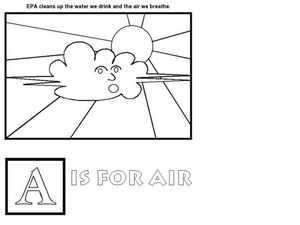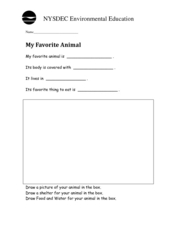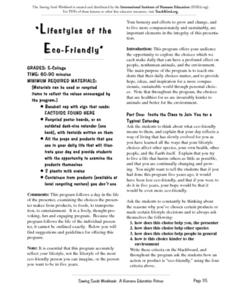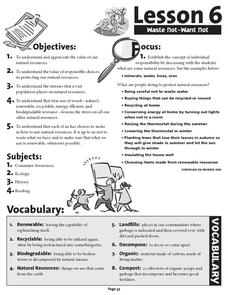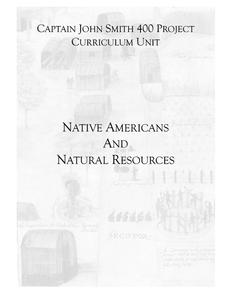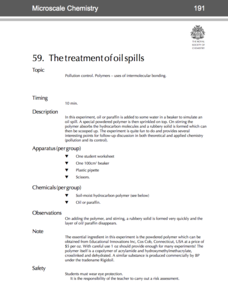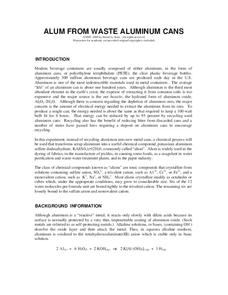Curated OER
A is for Air
In this air pollution worksheet, students read the phrase 'EPA cleans up the water we drink and the air we breathe, and 'A is for Air.' Students then color the picture of the sky, cloud, and sun.
Curated OER
NYSDEC Environmental Education
In this Earth environment worksheet, 2nd graders answer 4 questions about their favorite animal. Students must also draw a picture of that animal inside a shelter in the box provided.
Curated OER
Water Is Life
In this science activity, students color in the picture that portrays the environmental message about the role and necessity of water to support life.
Curated OER
Lifestyles of the Eco-Friendly
A helpful worksheet encourages pupils to make environmentally-friendly choices at home. The packet presents many ways that learners can help the environment, such as taking shorter showers in order to conserve water.
Curated OER
Soil Porosity, Moisture Content, pH, and Density
This lab activity does not have to be done with AP environmental scientists. It can also be done with middle to high school earth scientists. The procedures aren't complex. Learners determine the density of dry and wet sand in order to...
Curated OER
Reading Comprehension- Informational Passages "Pollution"
Practice reading comprehension through this pollution worksheet, which has learners read an informational passage on various aspects of environmental harm. Key terms are in bold, and are used on the next page in the comprehension...
Curated OER
The Oil Spill Quiz
For this oil spill quiz worksheet, students respond to 10 multiple choice questions in order to examine their knowledge of oil spills and their effects.
Curated OER
Aquaculture Productions Systems Quiz
In this aquaculture system activity, students complete 14 true or false and fill in the blanks questions. They rank 4 systems in order of intensity.
Curated OER
Pelicans in Peril
In this Gulf oil spill instructional activity, students examine an article regarding the brown pelican and the effects of the oil spill as well as a photograph.
Curated OER
Gulf Oil Spill Fill-In
In this Gulf oil spill instructional activity, students examine an article regarding basic facts about the April 20, 2010 oil spill and then respond to 25 fill in the blank questions. A word bank is provided.
Teach Engineering
Density Column Lab - Part 2
Groups suspend objects within layers of liquids to determine the densities of different liquids and compare them to the densities of objects calculated in Part 1. The groups then carefully test their calculations by layering the...
K12 Reader
Taking Care of Earth
Provide a brief introduction to ecology and conservation with a reading passage. Learners can read the text, answer the five related questions that are included on the page, and discuss the reading.
Chymist
Landfills and Recycling
Examine the nature of landfills through experimentation. Scholars build miniature landfills and monitor changes over a six-week period. Observations allow individuals to draw conclusions about the different types of trash and their...
NOAA
Prepare for the Storm!
Severe weather can occur with or without warning. Being prepared for any situation makes chances of survival that much greater. A brief activity suggests a list of items for an emergency book bag. The first page...
Forest Foundation
Waste Not - Want Not
Recycling is the focus in the sixth of a nine-lesson series devoted to forest ecosystems. Class members read an article about the responsible use of natural resources and ways to reduce land fill.
Curated OER
Native Americans and Natural Resources
North American Indian civilizations had already been in place for over 10,000 years before the arrival of European settlers. Introduce your young historians to Indian tribes that lived in the Chesapeake region in the...
Curated OER
Swimming With the Crabs!
In this environmental science activity, learners complete a graphic organizer (Frayer model) on blue crabs. They write an article using the given facts.
Curated OER
Ways To Go Green
In this environmental awareness learning exercise, students learn how to "go green" by reading 10 tips that can be used in everyday life. Students answer 10 multiple choice questions. This is an online interactive learning exercise.
Bridge
Mercury - Mercury is Rising
Hold a discussion in your class about the increase in mercury being found in fish that are caught commercially as food for humans. Given a worksheet, learners then calculate how much fish a person can safely eat each month to remain...
National Institute of Open Schooling
Heavy Metal Contamination
An informative lesson focuses on heavy metal contamination of environments. Classes read about, discuss, and answer questions pertaining to sources of heavy metals in the environment. To finish the 35th installment of 36, individuals...
Royal Society of Chemistry
The Treatment of Oil Spills—Microscale Chemistry
When oil spills happen, how is the oil cleaned up? Pupils of polymer science discover an amazing substance that turns oil into a solid during a microscale experiment. Individuals observe oil or paraffin before and after addition of the...
Chymist
Alum from Waste Aluminum Cans
Turn aluminum cans into pickles! An engaging experiment has learners chemically change aluminum into a substance with many purposes including the manufacture of pickles. After performing the chemical conversion, the experimenters verify...
Consumers Energy
The Cost of Electricity
How much is your toaster costing you every day? Young environmentalists calculate the monetary costs of household appliances based on their average consumption of wattage.
Cornell University
Weed IPM
Go on a weed hunt! Scholars gain insight into the characteristics of plants and examine the outdoor environment in order to identify five different types of weeds. Learners then show what they know with a one-page reflection.
